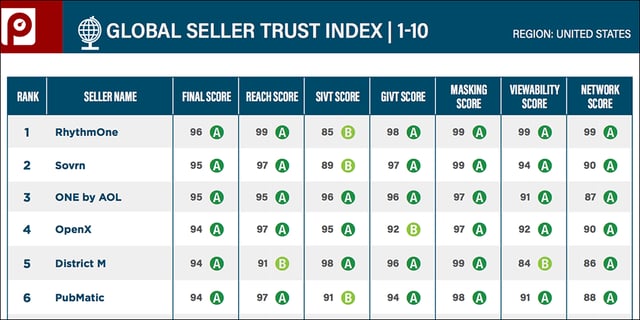
This week's review of ad fraud and quality in the digital advertising space.

Pixalate this week released the August 2017 Seller Trust Indexes, which rank the overall quality of programmatic sellers across desktop and mobile web, mobile in-app, and video. Google AdExchange made headlines amid quality concerns last month, but our latest rankings show that they have moved up a few spots. Download the full rankings.

Digiday uses four charts to explain the current state of ad fraud across the globe, including two charts featuring data uncovered by Pixalate's research team. "Japan has the highest ad fraud rates, according to a report from fraud prevention ad tech firm Pixalate. In the first three months of 2017, 81 percent of the programmatic impressions traded in Japan were fraudulent, with Brazil second at 36 percent. The U.S. was third with 35 percent of programmatically bought desktop ad impressions fraudulent during the same time period," Digiday wrote.

Advertising Age has reported that "MediaMath, one of marketers' more widely-used platforms to buy digital ads, announced Thursday that it will begin aggressively rolling out the 'ads.txt' initiative across its entire supply footprint." The article added, "As such, another major player in digital advertising has joined the industry's latest bid to cripple ad fraud. And yet, hurdles remain." Recent Pixalate research has revealed that fewer than 5% of Alexa Top 5000 sites have adopted ads.txt. You can download the full list of ads.txt-supported domains here.

AdExchanger has reported that marketers are warming to Facebook and Google "as they place blame for the industry’s many issues on its ad tech underbelly." Marketers are now focusing on the opaque supply chain, which is still rife with fraud.

"At the end of 2016, back before [P&G marketing chief Marc] Pritchard called out the 'crappy media supply chain' at an Interactive Advertising Bureau conference, P&G ran ads on about 2,000 sites per month in the U.S., according to Pathmatics," reported Digiday. "By August, it whittled that number down to 900 websites." The article added: "Among the many things Pritchard has clamored for in 2017 are more clarity on pricing and fees in ad tech, greater viewability and more vigilance in the fight against ad fraud, which can be accomplished by reducing the number of websites that brands place their ads on."
Sign up for our blog to stay updated with new stats, trends, and analysis on digital ad fraud.
*By entering your email address and clicking Subscribe, you are agreeing to our Terms of Use and Privacy Policy.
These Stories on Weekly Recaps
*By entering your email address and clicking Subscribe, you are agreeing to our Terms of Use and Privacy Policy.
Disclaimer: The content of this page reflects Pixalate’s opinions with respect to the factors that Pixalate believes can be useful to the digital media industry. Any proprietary data shared is grounded in Pixalate’s proprietary technology and analytics, which Pixalate is continuously evaluating and updating. Any references to outside sources should not be construed as endorsements. Pixalate’s opinions are just that - opinion, not facts or guarantees.
Per the MRC, “'Fraud' is not intended to represent fraud as defined in various laws, statutes and ordinances or as conventionally used in U.S. Court or other legal proceedings, but rather a custom definition strictly for advertising measurement purposes. Also per the MRC, “‘Invalid Traffic’ is defined generally as traffic that does not meet certain ad serving quality or completeness criteria, or otherwise does not represent legitimate ad traffic that should be included in measurement counts. Among the reasons why ad traffic may be deemed invalid is it is a result of non-human traffic (spiders, bots, etc.), or activity designed to produce fraudulent traffic.”

